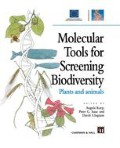Abstract
Microsatellites — also known as short tandem repeats (STRs) or simple sequence repeats (SSRs) — consist of tandemly repeated units, each between one and 10 base-pairs in length, such as (TG)n or (AAT)n (1). They are widely dispersed throughout eukaryotic genomes and are often highly polymorphic due to variation in the number of repeat units. The high information content of the genetic data yielded by microsatellite loci, and the advantage that material for microsatellite analysis can potentially be sampled non-invasively from free-living populations (2) make these markers one of the molecular tools of choice for many population and biodiversity studies. A protocol for the isolation of microsatellites is given in Chapter 15.1 and the characteristics of microsatellite loci in eukaryotic genomes are summarized in Box 11.1.
Access this chapter
Tax calculation will be finalised at checkout
Purchases are for personal use only
Preview
Unable to display preview. Download preview PDF.
References
Bruford, MW & RK Wayne (1993). Microsatellites and their application to population genetic studies. Current Opinion in Genetics and Development 3, 939–943.
Morin, PA & DS Woodruff (1996). Noninvasive genotyping for vertebrate conservation. Molecular genetic approaches in conservation, RK Wayne & TB Smith, eds., Oxford University Press, New York, pp. 298–313.
Francisco, LV, AA Langston, CS Mellersh, CL Neal & EA Ostrander (1996). A class of highly polymorphic tetranucleotide repeats for canine genetic mapping. Mammalian Genome 7, 359–362.
Karp A, Edwards KJ, Bruford M, Funk SM, Vosman B, Morgante M, Seberg O, Kremer A, Boursot P, Arctander P, Tautz D & Hewitt GM (1997). Molecular technologies for biodiversity evaluation: opportunities and challenges. Nature Biotechnology 15: 625–628.
Ziegle, JS, Y Su, KP Corcoran, L Nie, E Mayrand, LB Hoff, LJ McBride, MN Kronick & SR Diehl (1992). Application of automated sizing technology for genotyping microsatellite loci. Genomics 14, 1026–1031.
Chamberlain, JS & JR Chamberlain (1994). Optimization of multiplex PCRs. The polymerase chain reaction, KB Mullis, F Ferré & RA Gibbs, eds., Birkhause, Boston, pp. 38–46.
Taberlet, P, S Griffin, B Goossens, S Questiau, V Manceau, N Escaravage, LP Waits & J Bouvet (1996). Reliable genotyping of samples with very low DNA quantities using PCR. Nucleic Acids Res. 24, 3189–3194.
Smith, JR, JD Carpten, MJ Brownstein, S Ghosh, VL Magnuson, DA Gilbert, JM Trent & FS Collins (1995). Approach to genotyping errors caused by nontemplated nucleotide addition by taq DNA-polymerase. Genome Research 5, 312–317.
Ginot, F, I Bordelais, S Nguyen & G Gyapay (1996). Correction of some genotyping errors in automated fluorescent microsatellite analysis by enzymatic removal of one base overhangs. Nucleic Acids Research. 24, 540–541.
Slatkin, M (1995). A measure of population subdivision based on microsatellite allele frequency. Genetics 139, 457–462.
Goldstein, DB, AR Linares, LL Cavalli-Sforza & MW Feldman (1995). An evaluation of genetic distances for use with microsatellite loci. Genetics 139, 463–471.
Coote, T & MW Bruford (1997). Universally applicable microsatellites for analysis of genetic variation in apes and Old World monkeys. Journal of Heredity. 87, 406–410.
Editor information
Editors and Affiliations
Rights and permissions
Copyright information
© 1998 Chapman & Hall
About this chapter
Cite this chapter
Ciofi, C. et al. (1998). Genotyping with Microsatellite Markers. In: Karp, A., Isaac, P.G., Ingram, D.S. (eds) Molecular Tools for Screening Biodiversity. Springer, Dordrecht. https://doi.org/10.1007/978-94-009-0019-6_38
Download citation
DOI: https://doi.org/10.1007/978-94-009-0019-6_38
Publisher Name: Springer, Dordrecht
Print ISBN: 978-94-010-6496-5
Online ISBN: 978-94-009-0019-6
eBook Packages: Springer Book Archive

